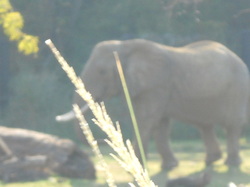African Elephant- Loxodonta africana
|
Range: Sub-Sahara Africa
Size: ♂: 366 cm ( 144 in) ♀: 274 cm(108 in) Weight ♂:7000 kg(15,435lbs) ♀: 4000 kg(8820 lbs) Habitat: rain forest, savannah And desert Estrus: 2 days Estrus cycle: 15-16 weeks Gestation : 366-377 days Litter: 1 Weaning: 48-108 month Sexual maturity: 120 months Lifestyle: Terrestrial Activity: Diurnal Social: female herds male bachelor groups Breeding: polygynous Movement: Migratory Food: leaves and fruit IUCN: Vulnerable Subspecies : 2 Longevity: captive: 32 yrs Wild: 56 |
The largest land animal on earth the African Elephant is recognized by children and adults worldwide. The difference between the African elephant and its closest relative the Asian Elephant are numerous but most often subtle. In the African species both males and females possess impressive tusks although the males are larger. In the Asian species only the male have tusk. The shape of the ears are also quite different in the species. And the trunk has two finger-like tips on the African and only one on the Asian.
The African elephant is extremely intelligent and quite social. The communication among elephants is very complicated and is just now becoming understood after many years of research. It has been discovered that African elephants can communicant over long distances through low frequency vocalizations. The social organization is also very complex and herd structure and individual relationships may change over time. The herd is led by a dominant female. Young males form bachelor groups but older males are usually solitary. The African elephant migrates starting at the beginning of the dry season and returns back to the home range during the rainy season. The species is monotypic. There are some references that classify the Forest Elephant (L. cyclotis) as a separate species. The DNA evidence has been supported and the separation into two species is now generally accepted. The most dangerous threat to the species is poaching for ivory. In most range countries the African elephant is listed as CITES I and all trade in ivory from elephants is illegal. In the remaining countries the species is listed as CITES II and the ivory trade is regulated. In 1989 the US Congress passed the African Elephant Conservation Act prohibiting the importation of raw ivory. |

